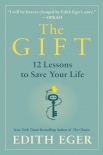Gift : 12 Lessons to Save Your Life Edith Eger (pdf e book reader TXT) 📖

- Author: Edith Eger
Book online «Gift : 12 Lessons to Save Your Life Edith Eger (pdf e book reader TXT) 📖». Author Edith Eger
But interestingly, there are other things she does with more flexibility and innovation. She’s always been an accomplished home chef, and once had a cooking column in a San Diego newspaper. After her fall, she has had to reteach herself how to cook. In the process, she has begun inventing new recipes and going about old processes in a new way. She and Rob live in Manhattan now, but they spend as much of the summer as they can in La Jolla, where I live. This past summer she wanted to make me a cold cherry soup she’d prepared once for a dinner party in New York. She bought a bunch of sour cherries and reread two old Hungarian cookbooks, only to abandon the cookbooks and go about it her own way—preparing the soup cold instead of heating it and then cooling it down, adding three different kinds of fruit. Without the constant adaptations she’s had to make since the injury, she probably would have made the soup the same way she had before. Instead, she embraced the practice of reinvention her injury has required and let it guide her to something new. And it was delicious!
I can see in her eyes sometimes how tiring and frustrating it is to work so hard to do things she once took for granted. But she’s also attuned to the possibilities.
“It’s funny,” she told me, “but I feel like I’m intellectually alive in a different way.” Her face lit up the way it had as a child when she’d learned to read. “To tell you the truth, it’s kind of fun and thrilling.”
This isn’t an uncommon experience for people who’ve survived similar injuries. Marianne’s neurologist told her a number of his patients, never skilled artists, suddenly found after a major brain injury that they could draw or paint—and do it remarkably well. Something about the broken and reconfigured neural pathways allows many survivors to find they’re in possession of gifts they never had or knew about before.
What a beautiful reminder that the things that interrupt our lives, that stop us in our tracks, can also be catalysts for the emerging self, tools that show us a new way to be, that endow us with new vision.
This is why I say that in every crisis there is a transition. Awful things happen, and they hurt like hell. And these devastating experiences are also opportunities to regroup and decide what we want for our lives. When we choose to respond to what’s happened by moving forward and discovering our freedom to, we release ourselves from the prison of victimhood.
KEYS TO FREE YOURSELF FROM VICTIMHOOD
That was then, this is now. Think of a moment in childhood or adolescence when you felt hurt by another’s actions, large or small. Try to think of a specific moment, not a generalized impression of that relationship or time of life. Imagine the moment as though you are reliving it. Pay attention to sensory details—sights, sounds, smells, tastes, physical sensations. Then picture yourself as you are now. See yourself enter the past moment and take your past self by the hand. Guide yourself out of the place where you were hurt, out of the past. Tell yourself, “Here I am. I’m going to take care of you.”
In every crisis there is a transition. Write a letter to a person or situation that has caused you pain, recently or in the past. Be specific about what the person did, or about what happened that you didn’t like. Put it all on the table. Say how the actions, words, or events affected you. Then write another letter to the same person or situation—but this time write a thank-you letter, expressing gratitude for what the person has taught you about yourself or how the situation has prompted you to grow. The goal of the thank-you letter is not to pretend to like something you didn’t like, or to force yourself to be happy about something painful. Acknowledge that what happened wasn’t right and that it hurt. And also notice the healing power in shifting your point of view from a powerless victim to who you really are: a survivor, a person of strength.
Harness your freedom to. Make a vision board—a visual representation of what you want to create or embrace in your life. Cut out pictures and words from magazines, old calendars, etc.—there are no rules, just see what attracts you. Paste the images and words to a sheet of poster board or a big piece of cardboard. Notice what patterns emerge. (This is a wonderful practice to do together with dear friends—and with plenty of good food!) Keep your vision board close by and look at it every day. Let this intuitive creation be an arrow to follow.
Chapter 2
NO PROZAC AT AUSCHWITZ
The Prison of Avoidance
One day when Marianne was five and we were living in a tiny apartment in Baltimore, she came home from school crying. She hadn’t been invited to a birthday party, and her heart was crushed, her face red with emotion, her cheeks covered in tears. I didn’t know anything about how to be present with feelings. I didn’t know how to let her have her own feelings. In those days, I was in complete denial about my past. I never spoke of Auschwitz. Even my own children wouldn’t know I was a survivor until Marianne was in middle school and found a book about the Holocaust. When she showed her father the pictures of starving, skeletal people in Auschwitz and demanded to know what terrible calamity had people dying behind barbed wire, it broke my heart to listen as he told her





Comments (0)